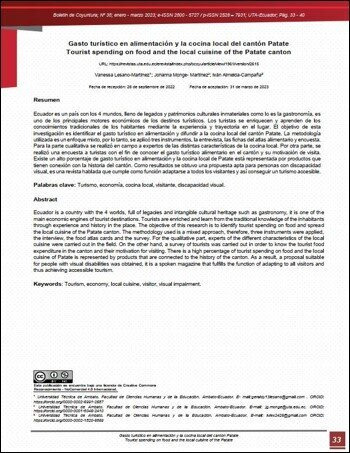Tourist spending on food and the local cuisine of the Patate canton
Main Article Content
Abstract
Ecuador is a country with the 4 worlds, full of legacies and intangible cultural heritage such as gastronomy, it is one of the main economic engines of tourist destinations. Tourists are enriched and learn from the traditional knowledge of the inhabitants through experience and history in the place. The objective of this research is to identify tourist spending on food and spread the local cuisine of the Patate canton. The methodology used is a mixed approach, therefore, three instruments were applied, the interview, the food atlas cards and the survey. For the qualitative part, experts of the different characteristics of the local cuisine were carried out in the field. On the other hand, a survey of tourists was carried out in order to know the tourist food expenditure in the canton and their motivation for visiting. There is a high percentage of tourist spending on food and the local cuisine of Patate is represented by products that are connected to the history of the canton. As a result, a proposal suitable for people with visual disabilities was obtained, it is a spoken magazine that fulfills the function of adapting to all visitors and thus achieving accessible tourism.
URL: https://revistas.uta.edu.ec/erevista/index.php/bcoyu/article/view/1961
Downloads
Article Details

This work is licensed under a Creative Commons Attribution-NonCommercial 4.0 International License.
![]()
The publications of the Boletín de Coyuntura are licensed under a Creative Commons Attribution-NonCommercial 4.0 International License (CC BY-NC 4.0). The Universidad Técnica de Ambato retains the copyright of the published works, and favors and allows the reuse of these, as long as: the authorship and original source of publication is cited, and they are not used for commercial or onerous purposes. The intellectual property of the published articles belongs to the authors.
References
Araújo, G., & Sevilha, M. (2017). Los viajeros y sus motivaciones. Dialnet, 26(1), 62-85. Recuperado el 15 de Marzo de 2022, de https://dialnet.unirioja.es/servlet/articulo?codigo=6324197
Castaño , J., Moreno, A., García, S., & Crego, A. (2003). APROXIMACIÓN PSICOSOCIAL A LA MOTIVACIÓN TURÍSTICA: VARIABLES IMPLICADAS EN LA ELECCIÓN DE MADRID COMO DESTINO. Estudios Turisticos(158), 5-41. Recuperado el 25 de Julio de 2022, de https://turismo.janium.net/janium/Objetos/REVISTAS_ESTUDIOS_TURISTICOS/91949.pdf
Catillo, A. (2021). Innovacion de la cocina local del Portoviejo. Universidad Tecnica de Ambato, Turismo y Hoteleria . Ambato: Universidad Tecnica de Ambato. Recuperado el 30 de Diciembre de 2021, de https://repositorio.uta.edu.ec/bitstream/123456789/33552/1/Castillo%20Cede%c3%b1o%20Alexandra%20Cristina_Carrera%20de%20Turismo%20y%20Hoteler%c3%ada.pdf
Dacosta, & Vázquez. (2007). Fermentación alcohólica. Scielo, VIII(4), 249-259. Recuperado el 16 de Junio de 2022, de http://www.scielo.org.mx/pdf/iit/v8n4/v8n4a4.pdf
Devesa, M., Laguna, M., & Palacios, A. (2010). Motivación, satisfacción y lealtad en el turismo: el caso de un destino de interior. Reme, XII(35-36), 169-190. Recuperado el 25 de Julio de 2022, de http://reme.uji.es/articulos/numero35/article9/article9.pdf
Fernandez, M. (2009). Turismo Accesible: Importancia de la Accesibilidad para el Sector Turístico. Entelequia(9), 211-222. Recuperado el 30 de julio de 2022, de https://d1wqtxts1xzle7.cloudfront.net/33567628/e09a11-with-cover-page-v2.pdf?Expires=1659056510&Signature=YPzXqLtMk6-hRoFWZJV7r2wOkIpdPqEaYhO6p-rI1ogvl7WxRm3rjDXtqxfyv~ihL8UTs3DvaGkWZFt1QXDVC0BSqqH2tm5wpgGT7QmhETuB9wN-lHbGHS-E1vT1eFOvvxry5fvwD41~XYDYN7ATZ
Fusté- Forné, F. (2016). Los paisajes de la cultura: la gastronomía y el patrimonio culinario. Scielo, 24(1), 4-16. Recuperado el 20 de Abril de 2022, de http://www.scielo.edu.uy/scielo.php?pid=S0797-36912016000100001&script=sci_arttext
García , F., Ramírez, R., & Gonzalez, A. (2016). Discapacidad visual. Cultura científica y tecnológica(51), 193-205. Recuperado el 30 de julio de 2022, de http://erevistas.uacj.mx/ojs/index.php/culcyt/article/view/954/890
Gomenz. (2002). Los secretos de las batidoras o la eficaz técnica del cocktail. La mdiguera(50), 78-78. Recuperado el 16 de Junio de 2022, de https://riunet.upv.es/bitstream/handle/10251/42095/LA_MADRIGUERA_050_007.pdf?sequence=4
Gonzáles , M., & Alonso, J. (2016). Sberes Ancestrales. 10(1), 165-194. Recuperado el 16 de Junio de 2022, de https://www.seer.ufrgs.br/index.php/EspacoAmerindio/article/view/61734/37890
Lacosta, P., & Briones, F. (2015). Historia de la chicha de uva: un producto típico en Chile. scielo, 33(2), 87-96. Recuperado el 16 de Junio de 2022, de https://www.scielo.cl/pdf/idesia/v33n2/art11.pdf
Mascarenhas, R., & Gandara, J. (2010). La gastronomía como atractivo turístico. Scielo, 19(5), 776-791. Recuperado el 20 de Abril de 2022, de http://www.scielo.org.ar/scielo.php?script=sci_arttext&pid=S1851-17322010000500011
Ministerio de Turismo. (24 de Mayo de 2022). EL GASTO TURÍSTICO DEL 24 DE MAYO DE 2022 DEJA 42 MILLONES DE DÓLARES. Recuperado el 27 de Septiembre de 2022, de https://www.turismo.gob.ec/gasto-turistico-del-24-de-mayo-de-2022-deja-42-millones-de-dolares/#:~:text=De%20acuerdo%20con%20las%20cifras,a%20los%20resultados%20de%202018%20
Molina , M., & Cánoves, G. (2010). TURISMO ACCESIBLE, TURISMO PARA TODOS: LA SITUACIÓN EN CATALUÑA Y ESPAÑA. Universidad de Murcia(25), 25-44. Recuperado el 28 de Junio de 2022, de https://revistas.um.es/turismo/article/view/109561/104151
Monroy de Sada , P. (2004). Introduccion a la Gastronomia. (Limusa, Ed.) Mexico: Noriega. Recuperado el 02 de Marzo de 2022, de https://books.google.es/books?hl=es&lr=&id=PVkjB8gN_EQC&oi=fnd&pg=PA7&dq=gastronomia+&ots=p_I7_o_TK7&sig=vDJC_IQJObhYJtIZaQkYBkEGFsM#v=onepage&q=gastronomia&f=false
Oliveira, S. (2007). La importantancia de la gastronomia en el turismo. Scielo, 16, 261-282. Recuperado el 25 de Julio de 2022, de http://www.scielo.org.ar/pdf/eypt/v16n3/v16n3a01.pdf
OMT. (2003). Organización Mundial del Turismo. OMT. Recuperado el 25 de Julio de 2022, de https://www.coe.int/es/web/cultural-routes/world-tourism-organization
Organización mundial del Turismo. (2017). SEGUNDO INFORME DE LA OMT SOBRE TURISMO GASTRONÓMICO: SOSTENIBILIDAD Y GASTRONOMÍA. UNWTO. Recuperado el 30 de Julio de 2022, de https://www.unwto.org/es/archive/press-release/2017-05-25/segundo-informe-de-la-omt-sobre-turismo-gastronomico-sostenibilidad-y-gastr
Organización mundial del turismo. (26 de Septiembre de 2022). EL TURISMO INTERNACIONAL SE SITÚA AL 60% DE LOS NIVELES ANTERIORES A LA PANDEMIA EN ENERO-JULIO DE 2022. UNWTO. Recuperado el 27 de Septiembre de 2022, de https://www.unwto.org/es/taxonomy/term/347
Rodríguez, D. (2018). TECNOLOGÍAS DE INFORMACIÓN Y COMUNICACIÓN PARA EL TURISMO INCLUSIVO. Scielo, 26(1), 125-146. doi:https://doi.org/10.18359/rfce.3142
Salazar, D., Guerrero, M., Núñez Jose, Zambrano, N., & Tixilema , E. (2018). Perfil del turista en funcion de sus motivaciones, gustos y preferencias. Ciencias y tecnologia, 2(4), 48-58. Recuperado el 25 de Julio de 2022, de https://cienciadigital.org/revistacienciadigital2/index.php/CienciaDigital/issue/view/15/1
Servicios turismo. (2022). Establecomeintos registrados. Recuperado el 27 de Septiembre de 2022, de https://servicios.turismo.gob.ec/index.php/turismo-cifras/2018-09-18-21-11-17/establecimientos-registrados


